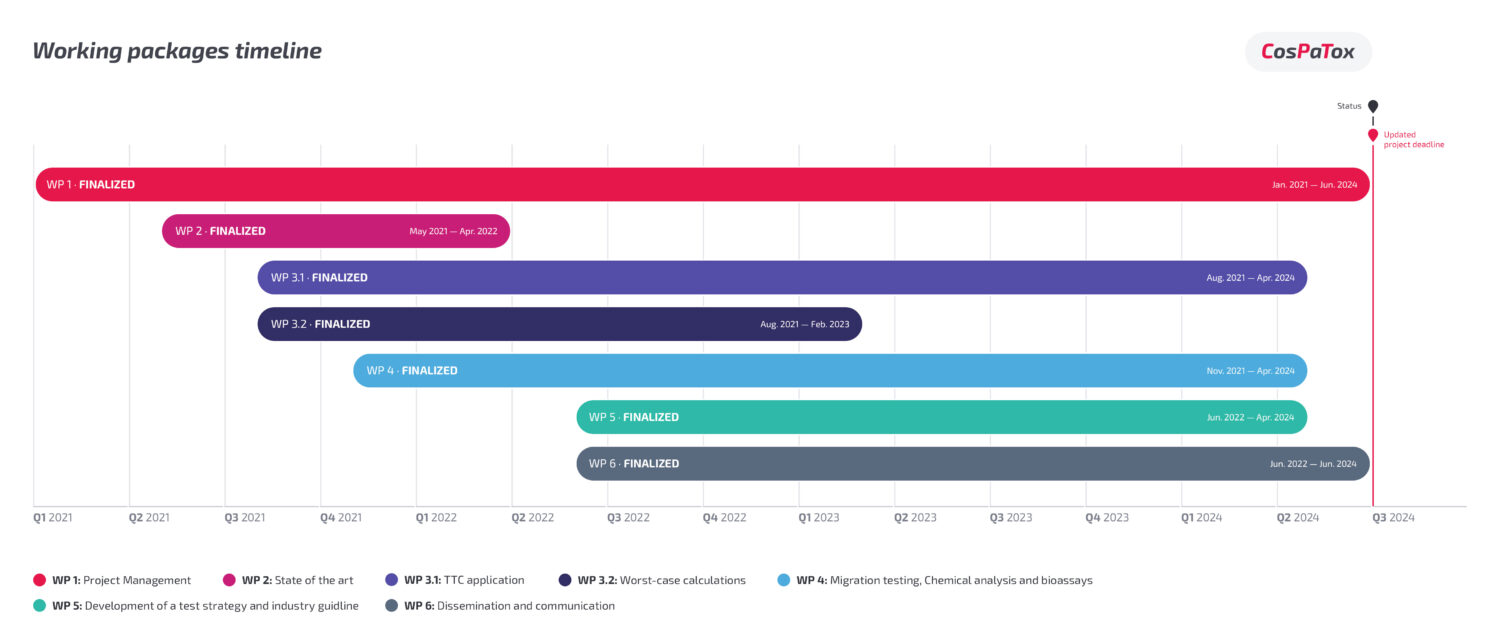The Project
CosPaTox engaged scientific experts in the field of post-consumer packaging waste recycling in order to implement a focused working program in cooperation with industry specialists from member companies.
CosPaTox partners are:
- Fraunhofer Institute for Process Engineering and Packaging IVV
- University of Applied Sciences Vienna
- Fabes Forschungs-GmbH for Analytic and Evaluation of Mass Transfer Processes
The CosPaTox Project work was split in six working packages to determine the minimal requirements for the application of PCR–recycling materials in plastic packaging.
WP 1: Project Management (Consortia Management, Steering Committee, Chair)
- Regular meetings of the working groups according to the demand of each WP and WP leader
- Administration of the technical part as well as the general administration and management of the project
- Coordination of the partners and consortium concerning samples and data/information
- Data/information anonymization
- The Steering Committee included one delegate per Core Member
- The CosPaTox Consortium engaged Michael Scriba as Chairman
WP 2: State of the art assessment of collect., sort., recycl. structures
- Assess material flows to determine where recycled materials are already in use or incorporated as packaging within the EU
- Characterization and description of input/output recycling streams and contaminants
- Collection of data from recycling companies and determination of requirements
- Literature study and input delivered by members
- identify possible contaminants (guidance list of disclosable substances)
- Recycling technologies
- The current market situation was assessed to gain information on the different products, where recycling material can be/has been used
- Input from consortium members and information on the content of the collected plastic waste „Gelbe Sack“
- Recycling companies share data concerning material flows and amount of non-compliant material
- The partners shared any possible contaminants and substances of risk. This will be compared to the guidance list by Cosmetics Europe
- Recycling companies shared their methods for evaluating the different process steps and their efficiency
WP 3: TTC Application & Worst case calculation
WP 3.1: TTC Application
- Determined how the TTC can be applied for cleaning and cosmetic packaging for the first toxicological evaluation
- Provided a comprehensive substance list; suggests candidate substances for monitoring
- Defined safe thresholds for substances on the list
- The TTC integrated for the first evaluation of the concept and assessed together with the obtained substance list
- From the knowledge obtained in WP 2, specific calculations was made on substances of interest
WP 3.2: Worst case calculation
- Calculated worst case migration scenarios and assessed the possible migration of:
- DNA reactive substances
- Other CMR substances
- Skin sensitizer
- Different applications: rinse off, leave on, cleaning products
- Used various exposure scenarios to determine the risk towards the consumer
- Migration simulation software was used to analyse the potential exposure scenarios
- The plastics of most interest (HDPE, PP, …) was used for estimations with different scenarios (rinse off, leave on)
- Consortium input on use cases
WP 4: Migration testing, chemical analysis and bioassays
- Develop/adapt migration testing and possible simulants
- Chemical and bioassay analysis of input material of recycling processes to assess worst case scenarios
- Characterisation of input/output streams
- Test polymer recycling material in chemical analysis and bioassays using sample preparation protocols and the Ames test ~30 samples can be tested
- Analysis of sensory effects of PCR products
- Migration testing was done with simulants of interest to reflect the properties of the cosmetic product (determine diffusion coefficients)
- Input and output streams was analysed to gain knowledge on the characteristics and toxicological profile of the different process steps (multi recycling steps). Determine efficiency of process steps in regard to genotoxicity
- The Ames MPF™ test was used to test migrates from input and output streams
- Sensory analysis of packaging products and analysis of volatile substances
WP 5: Development of a test strategy and industry guideline
- Test strategy for assessment of samples from recycling materials
- Industry guideline including recommendations for the assessment of a packaging product (input from the consortium!)
- Specific design for recycling guidelines
- Minimal standards for recyclates
- The consortium gave input on the minimal requirements for recycled materials for cosmetic and cleaning products
- Recommendations are published based on the project results
WP 6: Dissemination and communication
- Write peer reviewed publications
- Communication of the project, its goals and achievements
- Information to the consortium and its members on break through results

